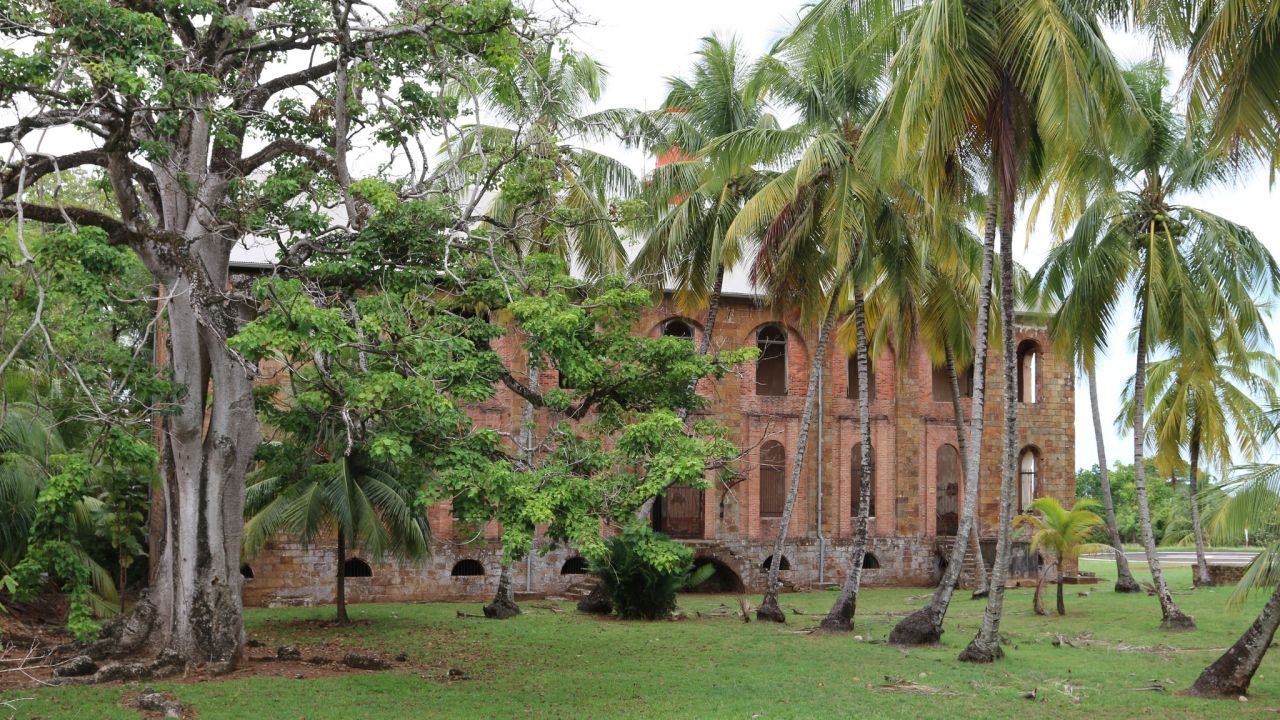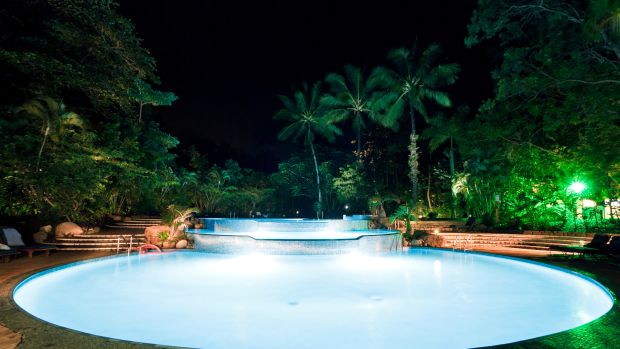[img via]
The cruiser taking visitors from Kourou on the French Guiana mainland to Devil's Island is smooth and swift, and the journey passes in an hour. But the boat is packed and, cresting the white-capped Atlantic swells off the north coast of South America, we look enviously at a helicopter bringing in more tourists. As we approach Royale, the largest of the three rocky islands that make up Devil's Island (nowadays known by their original name, the Iles du Salut), the warm breeze the sight of wind-bent palms and the smell of bougainvillea gives it a sense of Kuoni culture, rather than one of the most feared prison colonies anywhere in the world.
Devil's Island - the infamous "green hell" of legend - was a place no Frenchman would go unless sent by a judge. For here, and in prisons on the mainland, 60,000 prisoners endured a living death dubbed the "Dry Guillotine".
Now, 50 years after the last shackled convict returned to France, Devil's Island has become a macabre tourist attraction. Boats make regular trips and helicopters fly over the crumbling cell blocks, where vines and creepers seek to purge the island of its hideous past.
But this is just a facade. When the tourists have gone after the guide, and you stand on the wooden jetty that once echoed to the shuffle of shackled feet, it's not difficult to imagine the men in shapeless uniforms who died here. Their ghosts are everywhere in the crumbling ruins. On Royale the air of colonial France still lingers in the governor's house, the church, the hospital and admin blocks. Although time and foliage have softened their imposing features, the main prison blocks where 2,000 convicts were once imprisoned remain an eyesore. Clad in shapeless red and white striped pyjama pants, the prisoners shuffled from the workplaces to the cellblocks, thin-lipped and hollow-eyed, shadows of men who had long given up hope of escape or freedom.
During the period of its existence - from 1852 when Louis Napoleon III, the President of France, sent convicts to the colony to do the work once done by African slaves, until it shut down in 1946 - Devil's Island was synonymous with cruelty. Its dehumanising process was law and began as each consignment of convicts made the long 15-day trip from Marseilles to the mainland prison at St Laurent ont he northern tip of South America. Crammed in steel cages below decks, 80 to each cage, tempers flared as men fought for space nd food. Any threat of rebellion and jets of scalding steam were directed through the bars from overhead pipes. By the end of World War I, a converted German freighter, La Martiniere, was carrying its cargo of human misery to the settlements twice a year. Most of those aboard were replacements for those that had died of beatings, malnutrition and self-inflicted wounds.
"But don't forget," he added with a hint of menace, "we have two guardians: the jungle and the sea. If you don't get eaten by sharks or your bones picked clean by ants, you will soon beg to return."
Today, flying over the mainland across the chocolate-coloured Maroni River from Surinam, one can look down and see the sprawl of decaying jail buildings and ancient cell blocks, long since taken over by squatters. The impressive brick entrance is till there to the Camp de Transportation, leading to the vast parade ground where the commandant, resplendant in white uniform and pith helmet, addressed the ranks of naked new arrivals. He said he knew some would try to escape.
"But don't forget," he added with a hint of menace, "we have two guardians: the jungle and the sea. If you don't get eaten by sharks or your bones picked clean by ants, you will soon beg to return. Then you will be severely punished. You will get locked up in solitary. The first attempt will get you two years. The second attempt will get you five..."
Death was the only escape. The surrounding sea was infested with sharks, the rivers with piranha. The jungled teemed with army ants and alligators. It was a wildlife roll call of the planet's most threatening animal.
Once encamped on Royale, the prisoners would be forced into back-breaking, soul-sapping toil. Naked but for shoes and a straw hat, up to their waists in water, each convict was forced to cut a stire (one cubic metre) of hard wood every dady or receive nothing but a lump of dry bread. If the timber camps were overcrowded, others were put to work on the infamous "Route Zero", a sadistically futile road-building exercise. In over 40 years of hard labour, Route Zero never passed 25km in length.
For those who repeatedly broke the strict rules - or, on the verge of insanity, did crazy things - the ultimate sanction was a living death on the nearby isle of Saint Joseph, known to the convicts as "mangeuse d'homme", the devourer of men. In this jungle hellhole, fiendishly designed to break the body and spirit, men went mad after years spent in solitary confinement - the "reclusion disciplinaire". Left in total darkness, they were forbidden to speak, not even to the guards who pushed food through the flap in the heavy iron doors. Some were bricked up in the individual dungeons, cramped cylinders of stone lit only by a three-inch hole high in the wall. Others were kept in concrete pits with iron bars above their heads.
Find the cells today, under the blanket of rotting coconut husks and jungle vines, is difficult. And for the unwary, the first sight of agoutis (huge rat-like creatures) feeding on fallen fruit is scary. Everything is wet, decayed and haunted. Push open the rusting remains of a cell floor and part of it collapses. Inside, against one wall, are two decaying planks which once served as a bed. Scratched above, barely readable, is a pathetic prayer to a god that didn't hear. Another declares simply, "A Woman Put Me Here".
In another crumbling cell block where vines as thick as a man's arm embrace the rusting bars, the eyes diiscern a narrow corridor with rows of facing doors each side. Behind each door, at least four inches thick, is a cramped bare cell. There is no window and when the door clanged shut, it must have felt like being buried alive. In these conditions, death often came as a blessed release.
But even the elite were subjected to a regime so perverse it made Oz look like Porridge. Shackled all night, unable to twist or turn, always prey to vampire bats that roosted under the corrugated iron roofs.
Away from the smell of the damp and decay, beneath a blue sky just visible above the canopy of trees, you stumble upon a series of concrete pits barred at ground level by rusting iron grids. These are the "bear pits", seven feet wide, 12ft long by 12ft high, where prisoners were kept exposed to the elements at all times. Today, young palms sprout from fallen coconuts. It's hard to believe these appalling punishments remained French law until the start of World War II.
Jailers and survivors would speak of how easily men went mad. Others, reduced to mindless, emaciated animals, were left in the fetid darkness of the punishment cells waiting to die. The forger, Fredric La Grange, tells how prisoners in solitary lay on their wooden boards, "their legs fettered to an iron bar, staring at any light coming from a small hole, just waiting... waiting... waiting." La Grange died in 1964. As a liberte, of freed prisoner, he was stabbed in the back in a bar in Martinique.
The smallest island - Devil's Island itself, still out of bounds to today's visitors - was the dumping ground for the elite of France's high-ranking political prisoners. Most notable of all was Captain Alfred Dreyfus, falsely imprisoned for spying from 1895 to 1899 and kept in total isolation. In 1900 he was pardoned after the publication of novelist Emile Zola's J'Accuse, a fierce condemnation of the French Government's involvement in what became known as the Dreyfus Affair.
But even the elite were subjected to a regime so perverse it made Oz look like Porridge. Although there was no chance of escape, Dreyfus was still shackled all night, unable to twist or turn, always prey to vampire bats that roosted under the corrugated iron roofs. Invisible in the darkness, despite their huge wingspan, the bats waited for their victim to fall asleep. Then, hovering silently over his feet, the bat would strike, sinking its sharp teeth into the flesh to feed on the convict's blood. Just one more of the colony's arsenal of horrors.
Despite the virtual impossibility of escape, some did achieve it. One man who made it back to civilisation, was safe cracker Henri "Papillon" Charriere, so called for the butterfly tattoo on his chest. Framed for murder, he was transported there in 1930 from I'lle de Re, off La Rochelle in France, and spent 13 years on Royale. His best seller Papillon, published in 1970, was eventually made into a harrowing film starring Steve McQueen as Charriere, and Dustin Hoffman as fellow convict Louis Dega who allegedly kept a fortune in francs stuffed up his rectum. It was all in vain.
Viewing the sea from the rocky point where the dead were thrown to the sharks, one wonders how Papillon figured every seventh wave was so powerful that he could be swept out to sea on a sack of coconut shells. But that is how he eventually escaped. Today, there are few, if any sharks around; only turtles. But when there was a plentiful supply of bodies, their fins were a familiar sight when the bell rang from the prison church. This was their cue for feeding time as more bodies would be tossed into the water.
Death was the only escape. The surrounding sea was infested with sharks, the rivers with piranha. The jungled teemed with army ants and alligators. It was a wildlife roll call of the planet's most threatening animal.
Another convict, Rene Belbenoit also made it back to the outside world after six years on the islands, using a hundred dollars earned advising a film crew to buy a canoe full of supplies from a Chinese merchant. He also wrote of his experiences. Lugging his manuscript wrapped in oilskin, he spent almost a year with a tribe of Indians before pushing on through the forests of Honduras and Guatemala, to stagger toothless and broken, across Mexico and into the United States. The resulting book, Dry Guillotine, was a publishing sensation, printed 14 times in just two months after its 1938 release. Belebenoit's dissection of the islands' legacy of brutality was instrumental in swaying public opinion toward the colony's closure.
But these were the exceptions. Out of 60,000 convicts that sweated and starved in the name of French justice, less than 2,000 would return alive. They were given second-hand clothes by the Salvation Army and left to fend for themselves. So what is the appeal for tourists today? Partly, perhaps, because of the movie. And maybe a ghoulish curiosity in the atrocities that went on here. And what will it be like tomorrow? Perhaps there will be a McDonald's and a Devil Island's Holiday Inn.
Click here for more Travel stories
Click here to follow Sabotage Times on Twitter
Click here to follow Sabotage Times on Facebook


